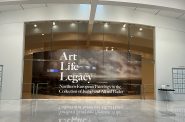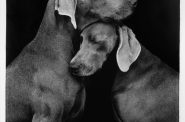Alluring and peculiar exhibitions of self-taught art
Exhibitions at Dean Jensen and Portrait Society feature self-taught artists who offer inventive and imaginative views of everyday life and otherworldly places.
Naïves, Seers, Lone Wolves & World Savers XXIII at Dean Jensen Gallery and Waste Not: Five Regional Self-taught Artists at Portrait Society Gallery feature the work of artists who come from outside the traditional realm of art schools and tutelage in the history of visual culture. Generally speaking, these criteria help define the parameters of self-taught art.
The term “self-taught” is fraught with conditions and qualifications. Aren’t all artists self-taught to a degree, finding their voice by experimentation and individual vision? And aren’t all artists affected by external influences? The term “self-taught” is an indefinite and slippery signifier, but there are qualities reflecting inventive imagination and a sheer will to power that permeate this field.
Now in its twenty-third iteration, Dean Jensen’s exhibition Naives, Seers, Lone Wolves & World Savers represents an iconoclastic group of artists, each with a distinct style and manner of handling their medium. One of the exciting aspects of many works is a sense of daring, an approach that takes chances in the details of construction, such as Purvis Young‘s Parade. Young adopts techniques found in some of the earliest known forms of art, arranging his figures on ground lines in multiple registers. In the top register a line of figures undulate; it is orderly and comparatively restrained, but not without a hint of energy held at bay. In the middle register the momentum starts to discharge, and by the time we reach the bottom of the composition the parade has combusted into a chaotic melange of bodies. Is it exuberance or nihilism? Young goes far with the boisterous spill, releasing it beyond the boundaries of the frame, breaking the conventional, polite parameters of picture making.
Clementine Hunter also exemplifies an expressionistic tendency, fixated more on the feeling of a place rather than representation that mirror ordinary sight. She is descriptive in the way things are reconfigured: the objects most important or interesting live largest in the mind and in the painting. Plantation Caning uses the vibrant colors Hunter is known for, and her free manipulation of scale and perspective makes the work dramatic. Her brushwork lays down a feathery backdrop of land where a diminutive person wheels a cart. What looms largest are the goods: the produce and products set aside, rendered in bursts of color and impasto paint amidst the grasses.
Romano “Mano” Johnson, getting his first showing in Milwaukee, composes looming flat images of vibrant color and pattern, representing figures and images from pop culture. Michael Jackson and motorcycles are two motifs, both imagined in complex painted worlds where figures float in shallow pools of cryptic signs and symbols.
A peculiar world is often created in self-taught art, as though the need to bring to life a desired place is a driving impetus for making things. Bernard Gilardi and Rudy Rotter, two artists who are part of the Portrait Society stable, speak to this tendency. Rotter’s couples cavort in a seeming lost Edenic paradise of sensual simplicity, while Gilardi’s surrealistically-tinged world stretches and transforms human beings and fanciful animals amid colorful, glistening landscapes and water.
The contours that loosely shape the self-taught realm are often about matters of origin, a definition based on where and how the work of the artist came to be. There is no defining style, but if anything could be an embracing characteristic that widely applies to this territory, it is perhaps a spirit of confident self-fulfillment. Broadly speaking, self-taught artists often create primarily to satisfy their own compulsions, and through twists of fate and and a bit of luck their work sees the light of day in the formal art realm. Taken together, these exhibitions offer a vibrant survey of artists on their own path, in pursuit of their own visions.
Naïves, Seers, Lone Wolves & World Savers XXIII continues at Dean Jensen Gallery (759 N. Water Street) through September 7.
Waste Not: Five Regional Self-Taught Artists continues at Portrait Society Gallery (207 E. Buffalo Street, 5th Floor) through September 22.
Art
-
Exhibit Tells Story of Vietnam War Resistors in the Military
 Mar 29th, 2024 by Bill Christofferson
Mar 29th, 2024 by Bill Christofferson
-
See Art Museum’s New Exhibit, ‘Portrait of the Collector’
 Sep 28th, 2023 by Sophie Bolich
Sep 28th, 2023 by Sophie Bolich
-
100 Years Of Memorable Photography
 Sep 18th, 2023 by Rose Balistreri
Sep 18th, 2023 by Rose Balistreri




















“A chaotic melange of bodies” – great writing! Thanks for making these exhibits alive and vibrant and real for me, since I haven’t yet seen them!
Thanks, Christina!
[…] Review: Kat Murrell, Third Coast Daily […]